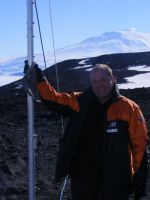 Craig Rodger(left, image: J.Dodgshun) from the Physics Department at the University of Otago is interested in how the sun's activity impacts Earth, and as part of that quest he is a member of a joint New Zealand-United Kingdom space physics project known as AARDDVARK, an acronym that stands for the Antarctic-Arctic Radiation-belt (Dynamic) Deposition - VLF Atmospheric Research Konsortium. Fifteen ground-based detectors in the Arctic and Antarctic provide continuous long-range observations of the lower-ionosphere using very low frequency radio waves, with the upper atmosphere serving as a gigantic energetic particle detector to observe and understand energy coupling between earth's atmosphere, the sun and space. One of these polar receivers is based at Arrival Heights in Antarctica, and Alison Ballance joins Craig Rodger at the laboratory to find out where the very low frequency radio waves come from, how they propagate around the earth's atmosphere and what they can tell us about solar energy.
Craig Rodger(left, image: J.Dodgshun) from the Physics Department at the University of Otago is interested in how the sun's activity impacts Earth, and as part of that quest he is a member of a joint New Zealand-United Kingdom space physics project known as AARDDVARK, an acronym that stands for the Antarctic-Arctic Radiation-belt (Dynamic) Deposition - VLF Atmospheric Research Konsortium. Fifteen ground-based detectors in the Arctic and Antarctic provide continuous long-range observations of the lower-ionosphere using very low frequency radio waves, with the upper atmosphere serving as a gigantic energetic particle detector to observe and understand energy coupling between earth's atmosphere, the sun and space. One of these polar receivers is based at Arrival Heights in Antarctica, and Alison Ballance joins Craig Rodger at the laboratory to find out where the very low frequency radio waves come from, how they propagate around the earth's atmosphere and what they can tell us about solar energy.
She discovers that the receiver has a dual purpose, as it also detects global lightning strikes that are fed into an international lightning detection system that goes by the acronym WWLLN (pronounced woollen).


